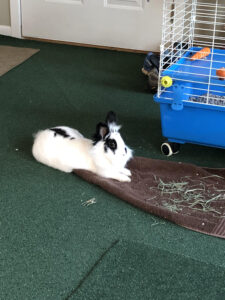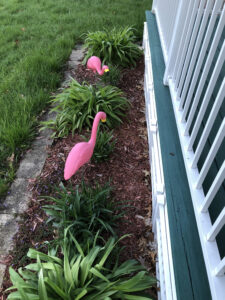With Kathleen Horan,
president and CEO of AbbeHealth
We are all now several months into coping with the novel coronavirus pandemic and subsequent COVID-19 disease.
It’s felt like having to walk across a high wire above Niagara Falls with no safety equipment. That stunt was done in 1859 by Jean-Francois Gravelet, also known as Charles Blondin. Totally dangerous. Crazy. Yet, Blondin understood the dangers and had prepared for many years ahead of time.
A salient lesson for today.
While initially, everything seemed topsy turvy in our world, many have found a semblance of a routine that has helped keep insanity at bay. Yet, as this wears on, we find we are wearing out.
Now is exactly the time to remain mindful. And, remember we do have individual and communal safety nets. So, let’s take a look at these.
The Importance of Routine
Kathleen Horan, director of AbbeHealth, points out that “Most people find comfort in routine and predictability. These fundamental comforts have been disrupted leading to anxiety and stress and sometimes a sense of helplessness because it feels like everything is out of control.”
While some compare the coronavirus pandemic with stressful and location-specific disasters such as floods, wildfires, hurricanes, or plane crashes, these disasters are different and require different responses.
“With the 2008 Epic Surge of floodwaters in Eastern Iowa, the lead up was relatively short-lived, the surge came and was devasting, and then we quickly moved in to clean up and recovery stage. We had things to do to start moving back to what we considered ‘normal’.
“With the novel coronavirus and the COVID-19 disease, the anticipation of what might be coming and the unknowns about what lies ahead are very difficult because it feels so out of our control.”
A joke going around is that while the Greatest Generation was called to go to war (WWII). We are called to the couch. We have developed “new” routines and habits. Let’s continue the positive ones after the pandemic has passed.
Revisiting the Grief Cycle and Spiral
With no obvious end in sight, many feel stuck. Spring’s warm weather is coming in the Northern Hemisphere. Fall’s coolness is settling below the Equator.
For those who don’t personally know anyone who has been sick or died, there is even a sense of unreality. Kind of “What’s it all about?” Then, something happens that jars us into the reality of the time. We sink into the sadness of grief.
Remember the cycle comes and goes. Sometimes we are up! Sometimes down for no discernable reason. And, random events trigger a re-visit to the anxiety of an event or time.
It helps to remember that the trigger was NOT the event. The memory is just that. A memory.
Horan reminds us, “Understanding the phases of grief can be helpful for managing the feelings you may be experiencing. There is no special order to the phases of grief that tend to flow back and forth.
- An early phase is Denial & Isolation. It may include a feeling or belief that this isn’t real or that what is happening does not affect us.
- Another phase is Anger. Often this stems from fear and focusing on what has been lost or the things we can’t do right now.
- Bargaining is sometimes referred to as “What If” or “If Only.” “What if I am careful to wash my hands, then I can go out and be safe.” “If only I had….”
- Sadness or Depression is another phase and can include feelings of hopelessness or helplessness.
- Acceptance tends to be an end phase. The recognition that the current situation simply is, and we can figure this out.
Moving back and forth between different phases is normal.
What is in Our Control?

A pet can help us stay calm.
Horan reminded us we DO have safety nets. “Now is a great time to practice self-care. That old adage ‘Put on your own oxygen mask first’ really applies. That we all take care of ourselves is essential. This isn’t selfish; it is important.” Care for yourself physically, emotionally, socially, and spiritually. Engage your mind and your heart. Then, we find we can reach out and support and inspire others.
- Exercise. If you haven’t had a routine or have fallen away from one, break activities into small chunks a few times a day. By the end of the day, you will have exercised more than you realize. This technique breaks up the monotony of being at home most of the time and improves your fitness which can boost your immune system.
- Practice deep calming breaths. Allow your ribs to expand, the diaphragm to drop down and the belly bulge out. After a few times, return to regular and mindful breathing.
- Mantra and mudra. The first is a short saying that helps focus your mind. Some examples that accompany a four-count breath are:
“I am all right.” “I am here now.” “I am calm now.” “I am safe here.” A mudra is a hand gesture. Again, with a four-count breath touch your thumb to each finger as you say a mantra. Together, the breathing, mantra, and mudra help focus your mind and allow positive hormones to counter stress. - Release tension from various parts of your body starting with your face and shoulders. Mentally move through your body to your feet.
- Other ways to help quiet your mind include: Meditate, journal, read or listen to inspirational music or words, and notice and appreciate the beauty of nature are all.
- Take care of a pet. Caring for another sentient being can give a sense of purpose and calm our nerves.
Horan points out that these simple activities center you in the reality of what is happening now, in this moment.
She adds, “Another great way to calm anxious thoughts is to focus on those things for which you are grateful. Start and end each day identifying five things that make you feel thankful. Write them down. Look at them when you feel distressed. This will help re-center you in gratitude.” And, gratitude produces side benefits.
Reach Out
The free, on-line Yale Class, The Science of Well Being with Dr. Laurie Santos, points out that when we do kind acts for others, we elevate both them and ourselves. Recently we found some flamingos in our yard and a note with homemade chocolate on our porch. My friend and I were bummed out that events we had planned got canceled. So, she and her husband cheered us both up with this hilarious and kind gesture.
The upshot

Make friends laugh!
In this “dangerous opportunity” time, doors do actually open for us.
- We can choose to follow current safety guidelines – stay home and wear protective gear when out. We can reach out by phone or other digital means to check on those we love, our neighbors, and our friends.
- We can work on those projects at home that we never get to but now have a little time.
- We can spend that extra time reading to or playing with our children.
Chris Klug, a skilled practitioner gently guided class members through a difficult week. He reminded us that life is like a spiral. We may remember an event or situation. The memory might trigger an emotion. Yet, we have moved from that actual time. It is OK to be with the feeling of grief. Then, as you can, practice the self-care techniques.
Lots have changed and returning to “normal” will not happen. We can right” this topsy-turvy time, adjust, adapt, and form new ways to live and create meaningful lives.

